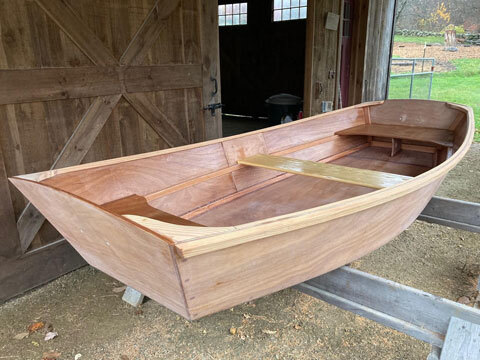Note: These plans consist of a booklet of 33 pages of text, drawings and color photos on 8.5" x 11" pages plus a large sheet of drawings. The printed version is black and white. To save $5 and postage costs choose the download option by ordering on this page. For PDF plans, click HERE
***********
a tough utilitarian design made for beach landings and rough water
The Montana Pram is 9’-5” LOA, beam is 4’-8” and the bottom width midship is 4’.
This little pram is an updated version of a boat we once carried on the deck of our sailboat. Its a tough utilitarian design made for beach landings and rough water. We often loaded out 90 pound dog, 5 gallons of water, bags of groceries and ourselves and rowed sometimes a half mile out to the anchored boat, in all kinds of weather. If you've ever tried to get an excited 90 pound dog out of a dinghy and into the cockpit of a pitching sailboat you'll understand the need for toughness and stability. It also had to be lightweight enough to lift on deck, and stowed on the foredeck it became our lifeboat. The pram is really just the no-frills mid-ship section of a dory, with the transom and pointed bow cut off, and this nine foot version is equally at home floating down a river, fishing on the bay or meandering across a backyard pond with the grandkids.
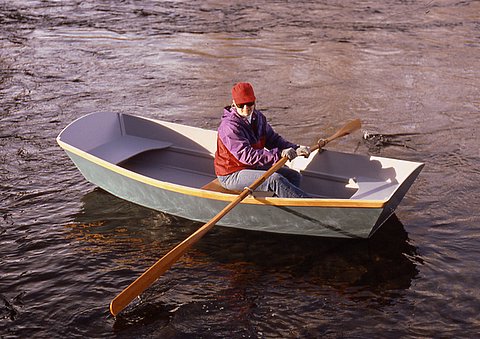
There are many options to customize the pram, and it can be fitted out as a killer fishing platform, lightweight dinghy or an all-purpose family recreational craft. It rows reasonably well and the smallest of gas or electric motors will push it right along.
Epoxy construction techniques and quality hardwood ply are recommended but the boat can also be built using lesser grades of ply and traditional methods. Ply panels are joined using simple epoxy glued butt-blocks so no exacting woodwork is required and the entire boat can be built of standard eight foot panels. The large interior butt-blocks, structural seats and stringers compensate for the lack of traditional ribs and bulkheads and keep the interior simple and clean. Both ends are identical so the pattern and building process is simplified.
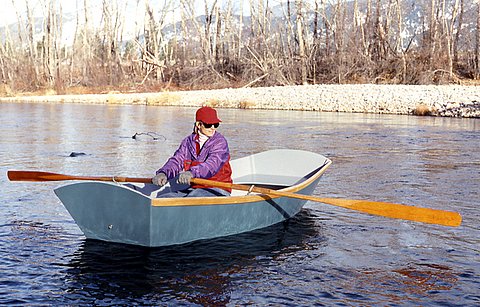
The boat can be made to weigh less than 50 pounds which makes it an easy car-topper that can be launched and retrieved by one person. Extreme duty versions can be beefed up by applying fiberglass cloth, tape or even Kevlar. With a tough slick graphite covered bottom the boat can also be dragged up and down launch ramps and across parking lots like a sled.
The interior can be arranged to suit and an extra seat can be installed along with extra oarlock positions to allow proper trim with a load. The pram can be equipped with a variety of seating options including fold-down swivel backrests or folding canoe seats. Small bean-bags placed on the bottom of the boat make comfortable stable seating for kids or adults. Build the seats removable and two or more prams will also "nest" together for storage or transport.
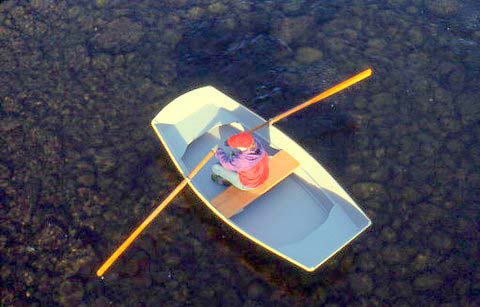
Trim wood can be softwood from your local lumberyard or exotic hardwoods. For our prototype dinghy we bought used canvas firehose, split it lengthwise and brass-tacked it around the sheer for cushioning when tied alongside. Sacrificial wood rubbing strips also reinforce and protect the bottom for beach landings and launch ramps, and provide directional stability when rowing or motoring.
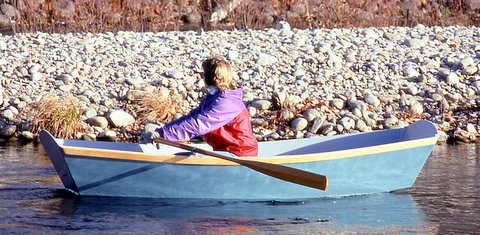
The simplified pram assembles quickly and without complicated procedures, and makes an ideal first woodworking project. The transoms and a temporary center section are used as a building base to provide support and a convenient building form during construction. A minimum number of tools are required and it can be built with a jigsaw, block plane, screwdriver and a few clamps. Build it with quality materials, maintain it with common sense, and you can give this boat to your grandkids in about as good shape as when it was new.
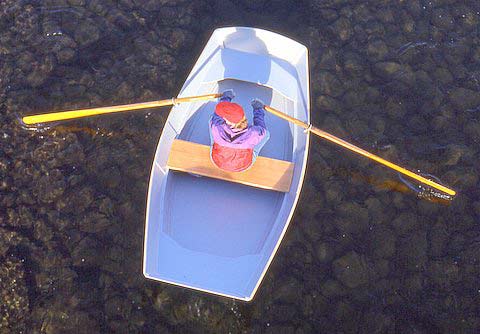
Building plans include blueprints and a 30 page illustrated step-by-step construction manual. Details include finishing and fitting out ideas, builders tips, material sources and lots of options for customizing.
**********
Builder Comments and Pictures
Paul...I wanted to share pictures of the Montana pram I’ve been working on, I wanted to build a small and stable rowing boat for my granddaughter (and parents!) to explore their 15 acre pond. It’s full of frogs, herons, turtles and fish and is big enough for adventures but not so big that they’ll get into trouble.
I bought a set of plans from Duckworks for your pram, and I slightly modified it by stretching it to 11 ft LOA. I’ve built several boats, and appreciate the simple yet functional and elegant lines of this pram. I added quarter knees, more because I like the looks than because they were needed. I ran out of warm weather this fall, so it’s sitting ready to paint and launch this coming spring. I just wanted to thank you for a beautiful design and I’m sure it will be just perfect for me to take my 2 granddaughters on some adventures.
Best, Ken
West Brookfield, Massachusetts**********
Paul, I finished the boat a week ago. Had inaugural float today! It's very stable for the size, should be just the ticket for trout this summer and salmon fishing this fall! I built it very open to maximize room and set it up for just one person and an outboard. I built it with 23" topsides instead of the 16" in case I run into higher waves on my favorite trout streams here in Idaho. It won't be used for real white water but the extra inches made me feel better.
Steve Heinrich
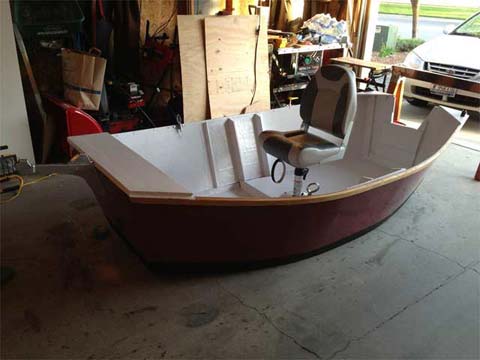
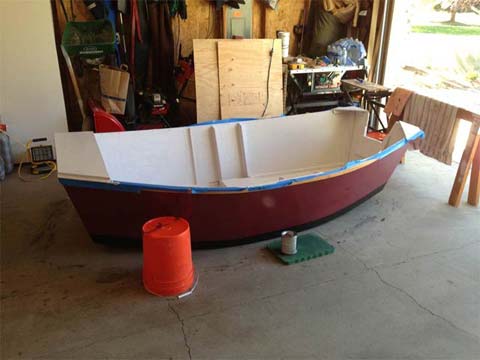
**********
Paul........I am so glad I was able to contact you. I am a great fan of your stuff, and I have I think, all of your Outdoor Life project articles. I've ordered plans from you in the past and built the Montana Pram. The plans are excellent but I no longer have the boat. I'm currently thinking about building the Camp Pod project then I might tackle the Montana Guideboat.=
Blake Jones=New York
**********
Hello Paul,
We have corresponded a few times as I was building a Montana pram from your plans. Well, it is done and I am very, very happy with both the building experience and the final product. I built it with the intention of using it as a stable platform for fly fishing. Then, I ended up moving to the coast (Santa Cruz, CA), where there are fewer flyfishing opportunities. I have been using it lately in the ocean (on calm days), fishing for halibut and rockfish near the beach. The boat has performed very well.
I have attached some pictures taken a week or so ago. I also added small triangular pieces on the four corners for more bracing to enable me to one day add jam cleats for hanging a second anchor.
Again, thanks for the plans. I had no practical woodworking or epoxy experience prior to building this pram. The plans were clear and not too difficult to follow for a rookie like myself. I am now trying to decide what boat project should be next.... thanks. Mike



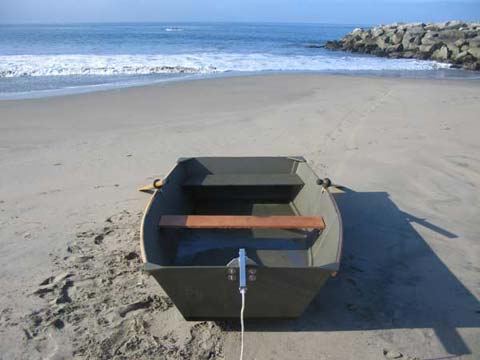
**********
Thanks Paul.
The Montana Pram plans are great!
Brian Duim
Washington
**********
Hello Paul,
....we purchased plans from you back in November for our son who wanted to make a boat for his senior project. The pram turned out great and we all learned a lot about boat building and enjoyed the project. Took about 4 weeks to build the boat and I believe he logged about 70 hours of work. The Pram will be used for trout fishing in the spring and duck hunting boat in the fall. We've had many compliments on the boat and many people have expressed an interest in building their own version. My son's name is Tyler and hes graduating from Tahoma High School in June. He earned an A on the project. Best
Regards,
Tammy
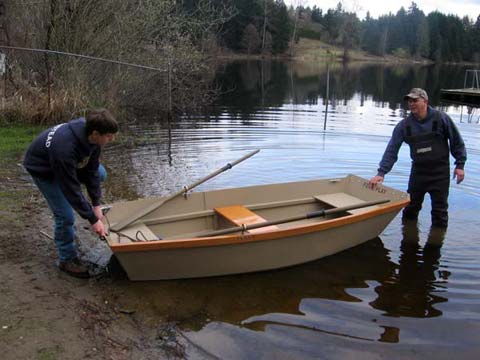
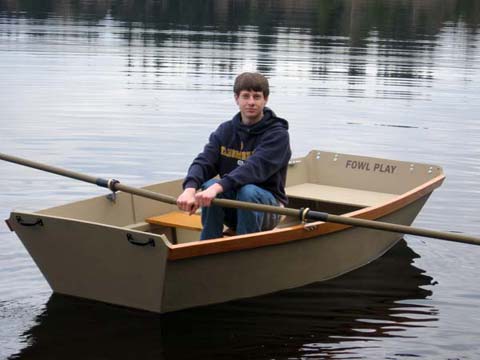
**********
.......we haul our pram on the foredeck of our 35 footer. I learned so much building the first one and after emailing you I decided to sell it to my neighbor and built a second lightweight version. After owning a number of fancy glass dinghies I really appreciate this lightweight woodie. Its so easy to build and even my wife can lift it on board.
Are you still building those compartmentalized rowing dories? I should have bought that prototype you had when we were up there and I had the chance.
Jarad H.
San Diego, CA
**********
Paul....I purchased plans for your Montana Pram and I am amazed at several things---the first is that I actually built a boat! I am still shaking my head at that. Second, it floats! Third, this little pram is really sturdy. I was surprised how strong it is. This is one tough boat, and finally, I built it to fish from and I am very satisfied and then I got carried away and built the oars. I have taken it to Canada several times now to fish lakes and enjoyed every minute. I take my cairn terrier Molly with me and she really enjoys being on the water with me. Why was I so surprised I could do this? My motto for building things has always been, "measure twice, cut once; go get more material and try again".
David Suver






